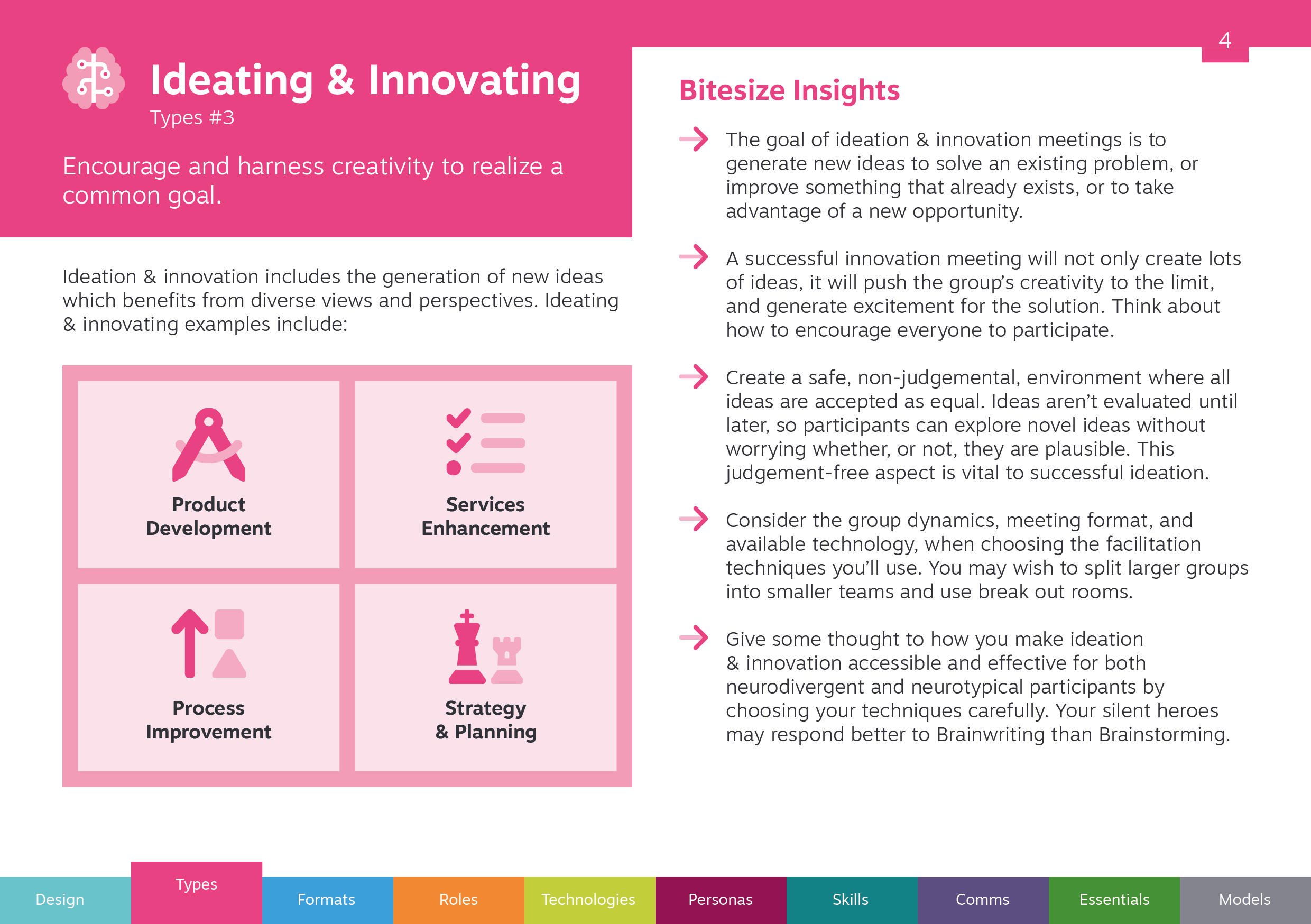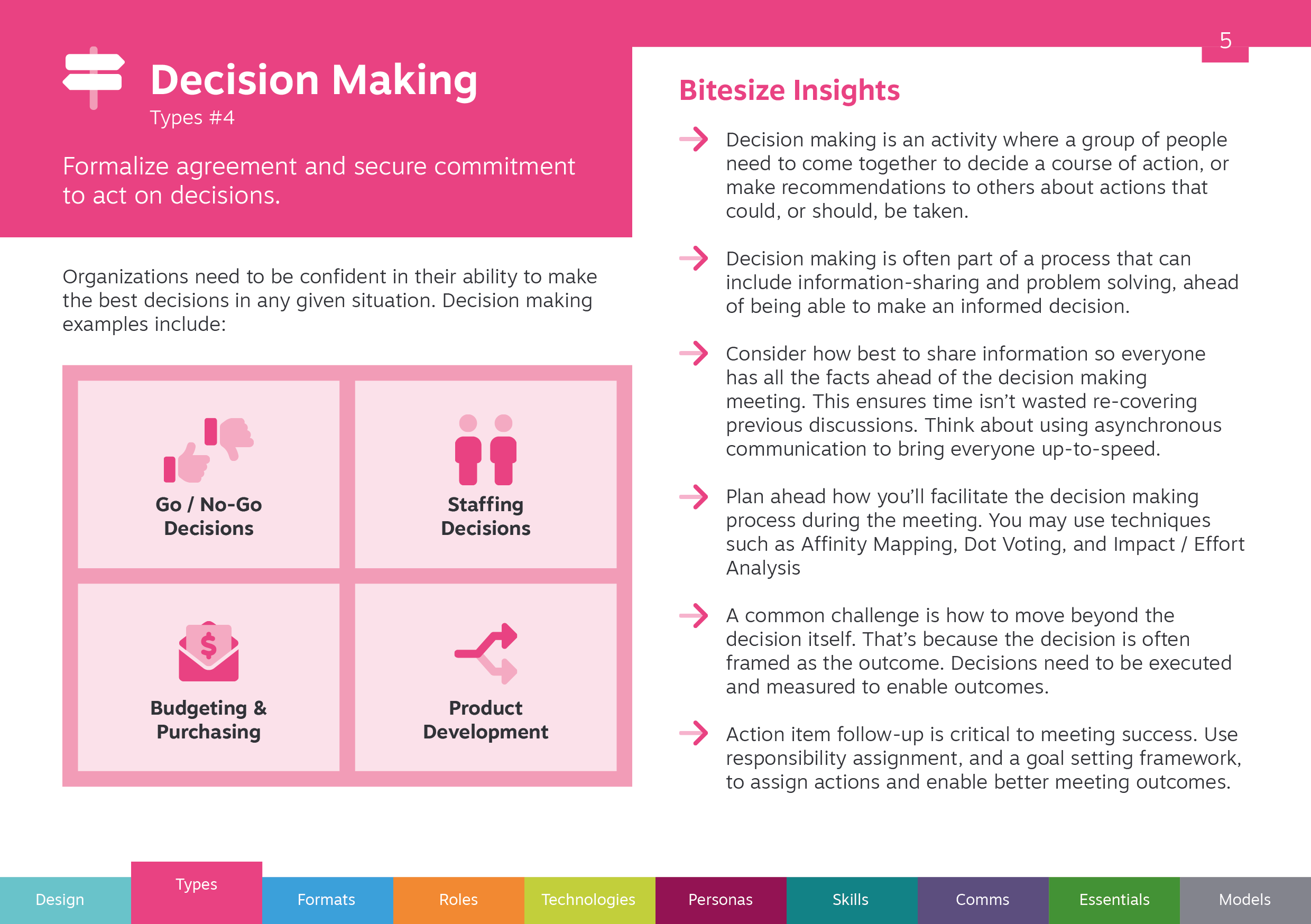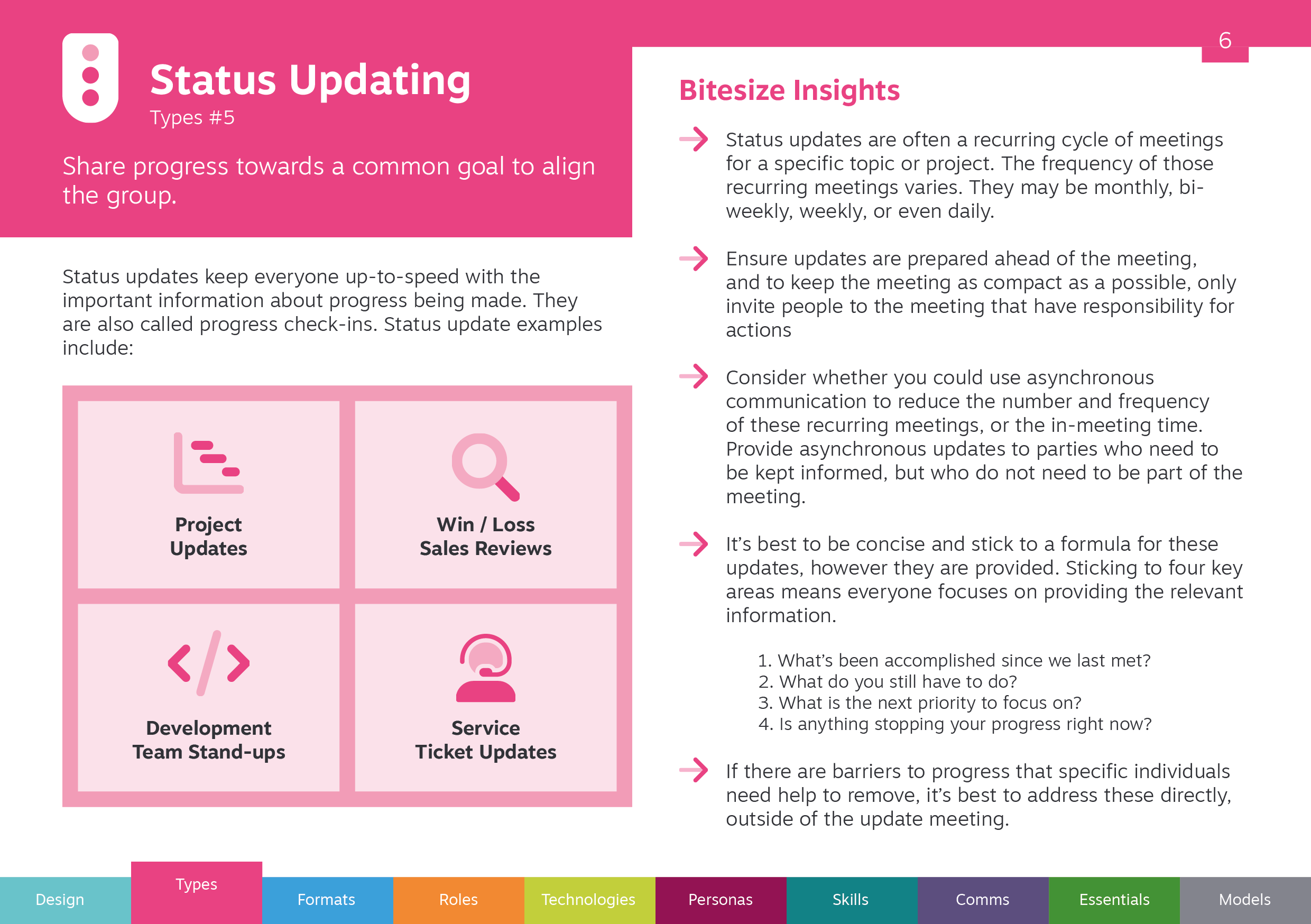In this Meeting Types section there are 7 cards for you to review.
The Intro card is always a great place to start, whatever section you are in. In the Meeting Types intro video, Jack listed the 6 different meeting types. He said, that while each of the types can be applied individually, in reality a number of them will often be used together.
We also talked about the difference between meeting labels and meeting types. Labels refer to the names that get applied to meetings e.g., a sales meeting, or a supplier meeting, or a finance meeting. ‘Types’ describe the activities that need to take place within the meeting to achieve the meeting’s objectives and deliver the required outcomes. There are an infinite number of labels, but a finite number of types. We believe that whatever meeting label you choose to use, the 6 meeting types will cover whatever activities need to be accomplished.
Take a moment to look at the Meeting Types intro card.
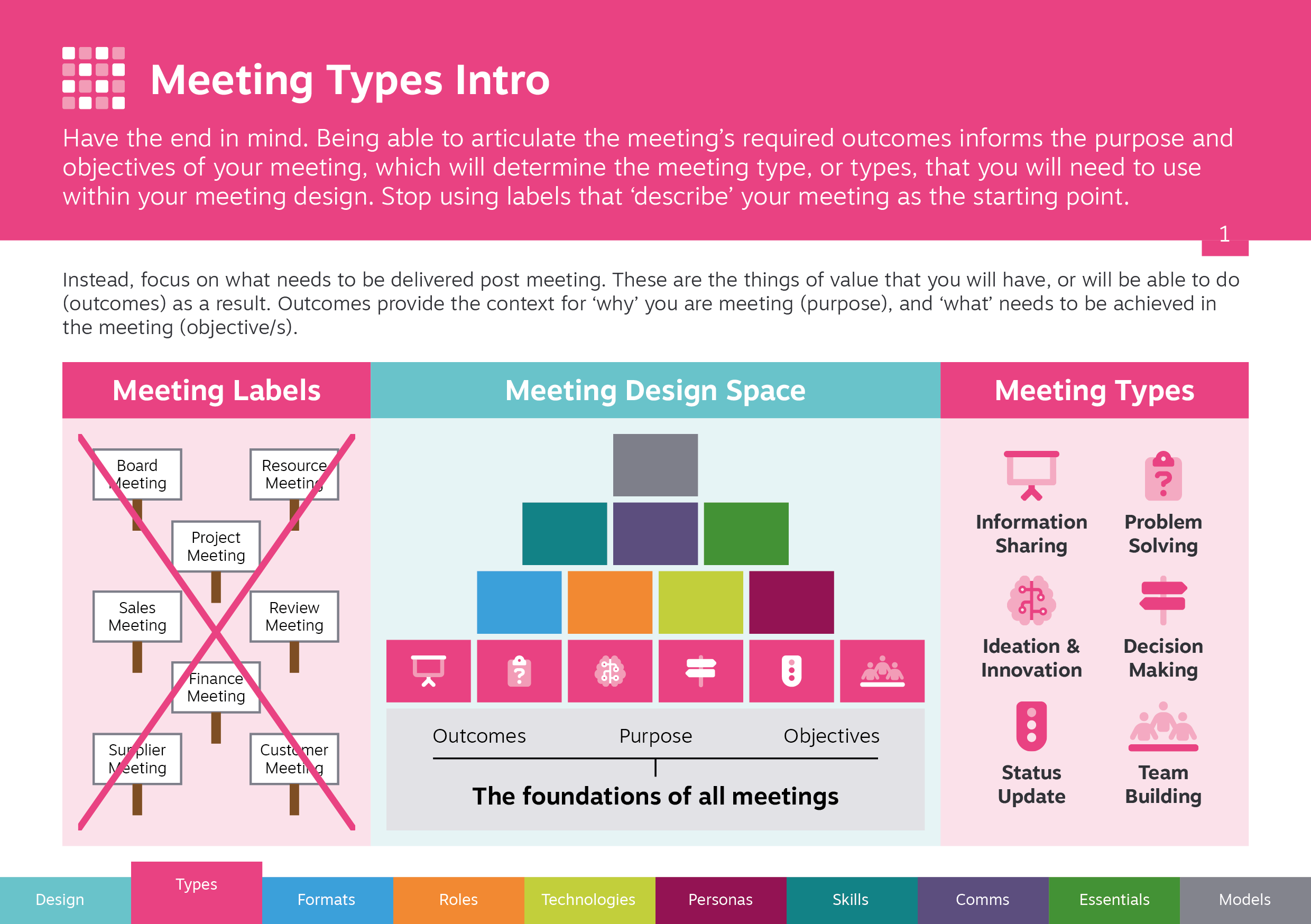
Think back to the purpose, objectives, and outcomes video in the Meeting Design section. You’ll see that meeting types are inextricably linked to the reason for meeting (purpose), the objectives of the meeting (what needs to be achieved), and the outcomes of the meeting (the things of value that will be delivered as a result of the meeting).
You must be able to articulate the purpose for the meeting, and it’s critical that you can identify the activities that align to achieving the objectives. This is where you need to be able to select the relevant meeting type, or types. If you can’t identify the necessary activities, it’s impossible to select and sequence the meeting types. This is why we position Purpose, Objectives, and Outcomes as the foundation of all meetings; and Meeting Types as the first building block of meeting design.
Let’s start by taking a look at information sharing meetings.
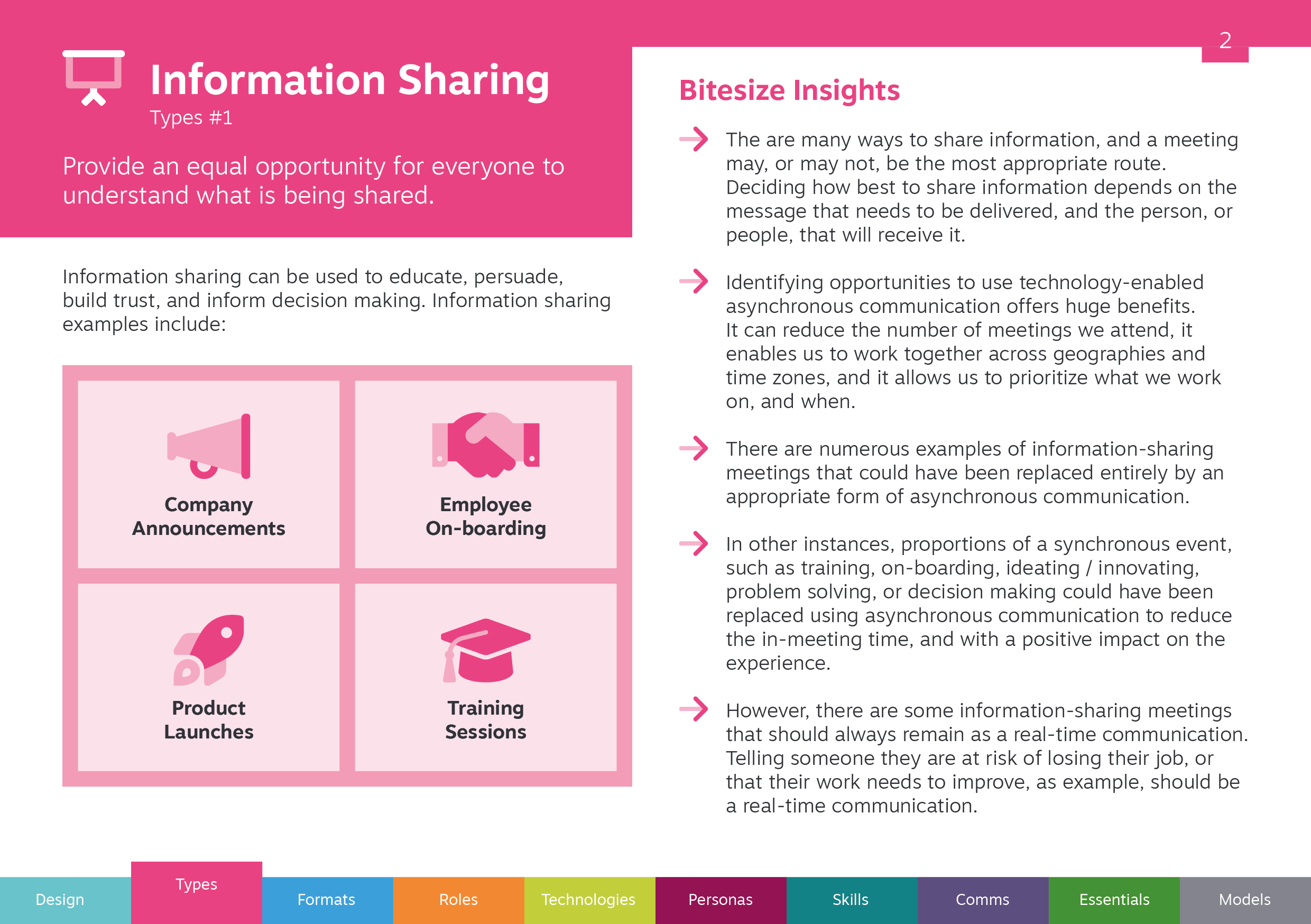
Every meeting, whatever its type, involves information sharing. However, not all information needs to be shared in a meeting environment.
As part of your meeting design process, it’s important to know what information needs to be shared, and how best to share it.
3 Questions To Ask Yourself...
Is an information sharing meeting really needed?
Firstly, you may not need a meeting to share information. If we are really focused on reducing the number of meetings, this is a good place to start.
How often have you walked away from a meeting thinking an email would have done the job sufficiently well? And, it might have done!
However, most of us get more emails than we can cope with, so while email may be a reasonable choice, it may not be the best choice. It’s worth thinking about the various, and appropriate, ways information can be shared. You may choose to record a message, to share documents, exchange messages, or use productivity applications.
Spoiler alert. In the Meeting Communications section, we’ll take a look at asynchronous communication. We’ll consider what it is, and when and how best to use it.
Could you reduce the in-meeting time with a better information sharing approach?
Remember the Meeting Decision Tree from the Meeting Design section? If, a meeting is the correct course of action,!
then deciding what information should be shared ahead of the meeting taking place, and how to share it, can cut down significantly the in-meeting time. It’s also an opportunity to help people prepare for the meeting, meaning they come ready to participate.
People will know why they’re invited, what they need to do to prepare, how they will take part, the contribution they will make, and what the likely next steps will be after the meeting. That’s great information to have.
When is an information sharing meeting the only appropriate option?
Of course, there are plenty of instances when meeting to share information is exactly the right choice. When a message needs to be delivered in real time, to everyone at the same time, then a meeting facilitates that type of delivery.
When you need to have conversations about, for example, job security, or performance, or significant change; then an information sharing meeting is the only appropriate approach.
Important insight.
Did you know that for many organizations, information sharing meetings are the most common meeting type, and if they aren’t the most common, then they come in at second place! That’s millions of meeting hours, every year, spent on sharing information.
Time Saving Tips
The two areas where most time gets wasted in meetings are:
- Telling people what they already know, and
- People arriving unprepared because they don’t have the full, or correct, information available ahead of the meeting.
This isn’t a case of never meeting to share information, but it is a case of being able to make a huge impact on the number of meetings, and duration of meetings, by knowing what information to share, and how.
By carefully assessing our information sharing meetings, we have a huge opportunity to cut out completely meetings that simply are not needed, or reduce the time spent in meetings that are required.
Ask yourself:
- Do we need to meet to share this information? If no, then how do we best share it?
- What information can be shared ahead of the meeting to reduce the in-meeting time? How best do we share it to provide equal opportunity for all participants to come prepared?
- Is this information sensitive (e.g., time, personally, professionally)? If yes, then this must be an information sharing meeting.
According to our research, problem solving meetings are right up there with information sharing meetings, in terms of prevalence. Let's take a quick look at the Problem Solving card...
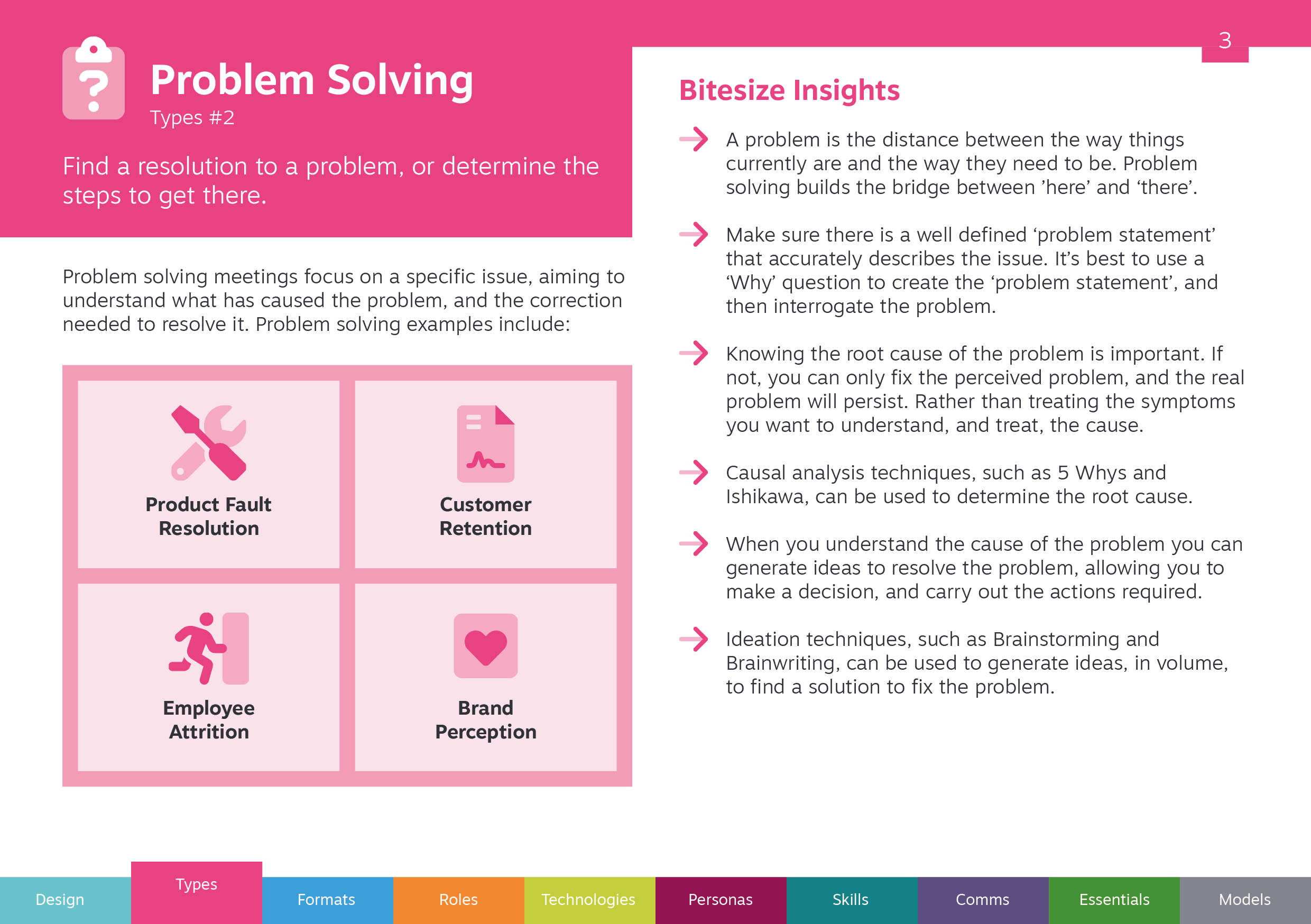
For many organizations that stated information sharing was their most common meeting type, problem solving meetings came in second. Conversely, for those organizations that said information sharing was their second most regular meeting type, then problem solving was often number one.
Problem solving is a really interesting meeting type. Solving a problem is part of the equation, but it’s rarely done in isolation. This is a great example of the need to bring various meeting types together to achieve a value outcome.
Consider this example:
- Purpose: solve a specific problem. Activity: information sharing so that everyone is on the same page.
Then you need to:
- Objective: understand the cause of the problem. Activity: problem solving – causal analysis to understand the root cause of the problem.
- Objective: generate some ideas to solve it. Activity: ideation to produce lots of ideas, quickly, to solve the problem.
- Objective: sort the ideas into categories. Activity: decision making to understand the groups of ideas and their relationships.
- Objective: impact versus effort. Activity: decision making to consider the benefits of the ideas versus the effort of implementing them.
- Objective: agreeing which ideas to action. Activity: decision making to select the ideas to implement.
When the decision has been made, you’ll need to:
- Required outcome: manage the actions and report on progress. Activity: status updating to keep the outcome delivery team, and the wider group of stakeholders, up to speed on outcome achievement, barriers, and barrier management.
Click the arrows to toggle between the cards: Ideating & Innovating, Decision Making, Status Updating
So, in this instance, problem solving requires information sharing, along with ideating and innovating, then decision making, and finally, status updating. These meeting types may, or may not, all come together into a single meeting. Irrespective, they are a process of meeting activities that are aligned to the meeting’s purpose, objectives, and outcomes.
'Compound Meetings'
Compound meetings, those meetings that rely on bringing multiple meeting types together, are complex. A well-designed meeting removes uncertainty, simplifies complexity, and eliminates ambiguity, creating better meeting experiences for everyone. Simplifying complexity is exceptionally important in compound meetings.
If problem solving meetings have the #1 or #2 prevalence ranking in many organizations, and we accept that in many instances these are complex to design and facilitate, why don’t companies invest more time in helping their staff, particularly meeting leaders, become more proficient at meeting facilitation?
Our own research suggests that 81% of people completing the Global Meetings Survey have never had any formal meeting training. While 64% of those surveyed want to develop their meeting skills and competences.
Let’s look at this from the meeting leader’s perspective when they are in charge of combining multiple meeting types. Their ability to facilitate complex meetings that combine a variety of meeting types, is critical to delivering the required outcomes. Strong facilitation and orchestration skills are required. They need to be accomplished meeting designers for the pre-meeting, in-meeting, and post meeting phases. They need to be great communicators, be capable of creating a safe environment for a diverse group of people, and they must not shy away from dealing with difficult situations. They must have a suite of techniques and tools that they are confident, and competent, to use during the course of the meeting. And yet, the majority of people leading these meetings have had no formal meeting skills development.
Now let’s look through the lens of the participants who are expected to make valuable contributions in complex meeting that combine various meeting type. Sitting in a poorly facilitated meeting is no-one’s idea of fun. Tempers fray, and frustration causes friction. Some people become louder and disruptive, while others become quieter and non-communicative. As a team, this group maybe exactly what’s needed to resolve the problem, only they aren’t a team. They are a bunch of disillusioned individuals who have better things to do with their own time, and with the company’s time and money.
When the first meeting doesn’t achieve what was expected, or perhaps hoped for is more accurate, there’s maybe a second attempt – another meeting. Same people, same approach, same ability, equals same result. Maybe there’s yet another attempt. We’re meant to be reducing the number of meetings, having fewer meetings of much better quality. If ever there was a case for meeting design, and for improving meeting skills, this must be it.
As we work through the various Better Meetings Building Blocks in the upcoming sections, we’ll provide you with insights, techniques, and tools that will help with the issues we’re calling out here. Couple these with the design framework, the 6Ps, and the design canvases, that we’ve already introduced, and you really will be on the road to fewer meetings of better quality.
Before we move on to the next building block, let’s take a look at Team Building meetings. Stick with it!
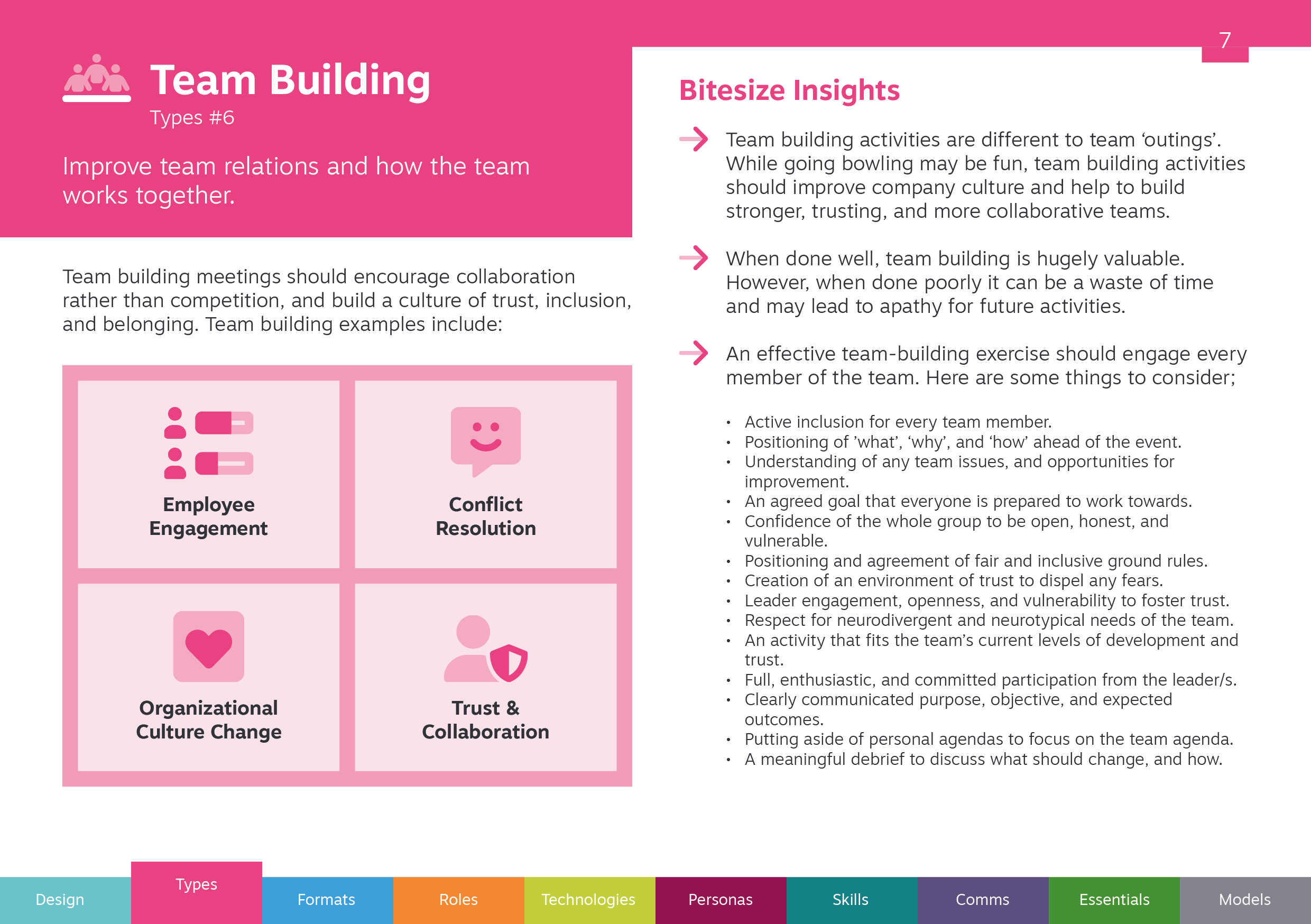
Team building meetings are quite different to the regular business meetings we encounter every day of our professional lives. It helps to consider this meeting type as an event. The Team Building meeting card provides some insights and considerations when planning and facilitating an event of this nature.
In this context the term ‘team building’ is being used to describe an event that brings colleagues together for a specific purpose, such as team engagement, or team development. However, well designed meetings create the opportunity for every meeting to be a team building activity. Meetings that are safe, inclusive, and productive positively impact the culture of the organization. The statement on the card that says “Team building meetings should encourage collaboration rather than competition, and build a culture of trust, inclusion, and belonging” is spot on. But that shouldn’t be the expectation just for the Team Building meeting type. That should be the expectation for absolutely every meeting type, in every organization. Teams and organizations that operate with high trust significantly, and consistently, out-perform teams and organizations with low trust.
So now think about what happens when meetings are not a positive experience. Poorly designed meetings are unlikely to create psychologically safe environments, there may be a lack of inclusion, trust can be eroded, and productivity is likely to suffer. Today we have too many meetings generally, and many of those meetings will fall into this ‘not a positive experience’ category. That’s bad for the business and hugely detrimental for everyone taking part in those meetings. Company culture and meeting culture go hand-in-hand.
Consider the insights on the Team Building meeting type card. They shouldn’t be limited to what we typically think of as a team building meeting, they should be at the heart of every meeting we lead, or participate in. Remember, the focus is not just to reduce the number of meetings, but to improve the quality of the necessary meetings. Part of that quality improvement is outcome delivery, but it should also include the meeting experience for those taking part.
